Submitted:
19 January 2024
Posted:
23 January 2024
You are already at the latest version
Abstract
Keywords:
1. Introduction
2. Materials and Methods
2.1. Study Area
2.2. Datasets
2.3. Methodology
2.3.1. Technical Process
- The required image collections were obtained by limiting the date range and the study area boundary. Cloud masking was then applied to each scene of the image collections. Spectral indices and elevation data were added as bands to each image in the image collections. The cloud-free composite images in the rainy and dry seasons were obtained by applying a mean reducer to the integrated image collections.
- To improve the efficiency and accuracy of surface water extraction, NDVI and MNDWI masks were used to remove obvious vegetation and non-water pixels.
- With MNDWI single-band grayscale images as references, sample points were first selected by visual interpretation. By comparison with the GLIMS Current dataset and JRC Monthly Water History, Version 1.3 dataset, the samples were revalidated and determined according to the principles of “complete consistency” and “temporal stability” of land type attributes [48].
- To further extract surface water, the RF model was applied for classification. Meanwhile, an approach was proposed to fill data gaps that existed in single-year rainy and dry season composite images. The rainy and dry season composite images from 1991 to 2021 were classified year by year to monitor the spatial and temporal changes in surface water extent in the YRB.
- Based on the hydro-meteorological factors, multiple stepwise regression modelling was applied to quantitatively analyze the impact of climate change on surface water dynamics. Factors that might affect the distribution of surface water due to human activities (e.g., inter-basin water diversion project and artificial control of surface water distribution using water conservancy facilities) were qualitatively discussed.
2.3.2. Data Processing
2.3.3. An Approach to Filling Data Gaps
- Since a single year’s rainy/dry season cloud-free composite images existed data gaps, we extended the data by constructing three-year period of image datasets (the previous year, the focal year, and the following year) during the rainy/dry seasons. The three-year period of cloud-free rainy/dry season composite images without data gaps were then obtained by executing the data processing procedure in Section 2.3.2;
- The RF algorithm was applied to the obtained composite images (including the three-year period of rainy/dry season composite images and the rainy/dry season composite images of any year within the three-year period) for classification to extract surface water. The data gaps existed in single year’s rainy/dry season composite images were filled using the extracted three-year period of rainy/dry season surface water, thus obtaining the single year’s rainy/dry season surface water without data gaps.
2.3.4. Removing Obvious Non-Water Pixels with NDVI and MNDWI Masks
2.3.5. Deployment of Sample Datasets
2.3.6. Random Forest Classification and Accuracy Assessment
2.3.7. Multiple Linear Stepwise Regression Analysis
3. Results
3.1. Accuracy Assessment
3.2. Spatial Distribution and Dynamic Changes of Surface Water Resources
3.3. Mechanisms of Surface Water Resource Change
4. Discussion
4.1. Extraction of Surface Water Resources throughout the Yangtze River Basin
4.2. Comparative Analysis with Existing Surface Water Datasets
4.3. Limitatios of Analyzing the Driving Fators of Dynamic Changes in Surface Water
5. Conclusions
Supplementary Materials
Author Contributions
Funding
Data Availability Statement
Acknowledgments
Conflicts of Interest
References
- Salman, M.A. United Nations General Assembly Resolution: International Decade for Action, Water for Life, 2005–2015. Water Int. 2005, 30, 415–418. [Google Scholar] [CrossRef]
- Goldblatt, R.; You, W.; Hanson, G.; Khandelwal, A. Detecting the Boundaries of Urban Areas in India: A Dataset for Pixel-Based Image Classification in Google Earth Engine. Remote Sens. 2016, 8, 634. [Google Scholar] [CrossRef]
- Mekonnen, M.M.; Hoekstra, A.Y. Four billion people facing severe water scarcity. Sci. Adv. 2016, 2, e1500323. [Google Scholar] [CrossRef] [PubMed]
- WWAP (UNESCO World Water Assessment Programme). The United Nations World Water Development Report 2019: Leaving No One Behind; UNESCO: Paris, France, 2019. [Google Scholar]
- UNESCO. The United Nations World Water Development Report 2020: Water and Climate Change; UNESCO: Paris, France, 2020. [Google Scholar]
- Vörösmarty, C.J.; Green, P.; Salisbury, J.; Lammers, R.B. Global water resources: Vulnerability from climate change and population growth. Science 2000, 289, 284–288. [Google Scholar] [CrossRef] [PubMed]
- Huang, C.; Chen, Y.; Zhang, S.; Wu, J. Detecting, Extracting, and Monitoring Surface Water From Space Using Optical Sensors: A Review. Rev. Geophys. 2018, 56, 333–360. [Google Scholar] [CrossRef]
- Woodcock, C.E.; Macomber, S.A.; Pax-Lenney, M.; Cohen, W.B. Monitoring large areas for forest change using Landsat: Generalization across space, time and Landsat sensors. Remote Sens. Environ. 2001, 78, 194–203. [Google Scholar] [CrossRef]
- Sawaya, K.; Olmanson, L.G.; Heinert, N.J.; Brezonik, P.L.; Bauer, M.E. Extending satellite remote sensing to local scales: Land and water resource monitoring using high-resolution imagery. Remote Sens. Environ. 2003, 88, 144–156. [Google Scholar] [CrossRef]
- Pittman, K.; Hansen, M.C.; Becker-Reshef, I.; Potapov, P.V.; Justice, C.O. Estimating Global Cropland Extent with Multi-year MODIS Data. Remote Sens. 2010, 2, 1844–1863.m. [Google Scholar] [CrossRef]
- Davranche, A.; Lefebvre, G.; Poulin, B. Wetland monitoring using classification trees and SPOT-5 seasonal time series. Remote Sens. Environ. 2010, 114, 552–562. [Google Scholar] [CrossRef]
- Pu, R.; Bell, S. Mapping seagrass coverage and spatial patterns with high spatial resolution IKONOS imagery. Int. J. Appl. Earth Obs. Geoinf. 2017, 54, 145–158. [Google Scholar] [CrossRef]
- Prigent, C.; Papa, F.; Aires, F.; Jimenez, C.; Rossow, W.B.; Matthews, E. Changes in land surface water dynamics since the 1990s and relation to population pressure. Geophys. Res. Lett. 2012, 39. [Google Scholar] [CrossRef]
- Cooley, S.; Smith, L.; Stepan, L.; Mascaro, J. Tracking Dynamic Northern Surface Water Changes with High-Frequency Planet CubeSat Imagery. Remote Sens. 2017, 9, 1306. [Google Scholar] [CrossRef]
- Prigent, C.; Jimenez, C.; Bousquet, P. Satellite-derived global surface water extent and dynamics over the last 25 years (GIEMS-2). J. Geophys. Res. Atmos. 2020, 125, e2019JD030711. [Google Scholar] [CrossRef]
- Zhang, D.D.; Zhang, L. Land Cover Change in the Central Region of the Lower Yangtze River Based on Landsat Imagery and the Google Earth Engine: A Case Study in Nanjing, China. Sensors 2020, 20, 2091. [Google Scholar] [CrossRef] [PubMed]
- Johansen, K.; Phinn, S.; Taylor, M. Mapping woody vegetation clearing in Queensland, Australia from Landsat imagery using the Google Earth Engine. Remote Sens. Appl. Soc. Environ. 2015, 1, 36–49. [Google Scholar] [CrossRef]
- Carroll, M.; Wooten, M.; DiMiceli, C.; Sohlberg, R.; Kelly, M. Quantifying Surface Water Dynamics at 30 Meter Spatial Resolution in the North American High Northern Latitudes 1991–2011. Remote Sens. 2016, 8, 622. [Google Scholar] [CrossRef]
- Ying, Q.; Hansen, M.C.; Potapov, P.V.; Tyukavina, A.; Wang, L.; Stehman, S.V.; Moore, R.; Hancher, M. Global bare ground gain from 2000 to 2012 using Landsat imagery. Remote Sens. Environ. 2017, 194, 161–176. [Google Scholar] [CrossRef]
- Pekel, J.F.; Cottam, A.; Gorelick, N.; Belward, A.S. High-resolution mapping of global surface water and its long-term changes. Nature 2016, 540, 418–422. [Google Scholar] [CrossRef] [PubMed]
- McFeeters, S.K. The use of the Normalized Difference Water Index (NDWI) in the delineation of open water features. Int. J. Remote Sens. 1996, 17, 1425–1432. [Google Scholar] [CrossRef]
- Xu, H. Modification of normalised difference water index (NDWI) to enhance open water features in remotely sensed imagery. Int. J. Remote Sens. 2007, 27, 3025–3033. [Google Scholar] [CrossRef]
- Salomonson, V.V.; Appel, I. Estimating fractional snow cover from MODIS using the normalized difference snow index. Remote Sens. Environ. 2004, 89, 351–360. [Google Scholar] [CrossRef]
- Choi, H.; Bindschadler, R. Cloud detection in Landsat imagery of ice sheets using shadow matching technique and automatic normalized difference snow index threshold value decision. Remote Sens. Environ. 2004, 91, 237–242. [Google Scholar] [CrossRef]
- Tucker, C.J. Red and photographic infrared linear combinations for monitoring vegetation. Remote Sens. Environ. 1979, 8, 127–150. [Google Scholar] [CrossRef]
- Sakamoto, T.; Van Nguyen, N.; Kotera, A.; Ohno, H.; Ishitsuka, N.; Yokozawa, M. Detecting temporal changes in the extent of annual flooding within the Cambodia and the Vietnamese Mekong Delta from MODIS time-series imagery. Remote Sens. Environ. 2007, 109, 295–313. [Google Scholar] [CrossRef]
- Deka, P.C. Support vector machine applications in the field of hydrology: A review. Appl. Soft Comput. 2014, 19, 372–386. [Google Scholar]
- Duan, Y.; Zhang, W.; Huang, P.; He, G.; Guo, H. A New Lightweight Convolutional Neural Network for Multi-Scale Land Surface Water Extraction from GaoFen-1D Satellite Images. Remote Sens. 2021, 13, 4576. [Google Scholar] [CrossRef]
- Earth Engine Code Editor. Available online: https://code.earthengine.google.com (accessed on 12 July 2021).
- Gorelick, N.; Hancher, M.; Dixon, M.; Ilyushchenko, S.; Thau, D.; Moore, R. Google Earth Engine: Planetary-scale geospatial analysis for everyone. Remote Sens. Environ. 2017, 202, 18–27. [Google Scholar] [CrossRef]
- De Alban, J.D.T.; Connette, G.M.; Oswald, P.; Webb, E.L. Combined Landsat and L-Band SAR Data Improves Land Cover Classification and Change Detection in Dynamic Tropical Landscapes. Remote Sens. 2018, 10, 306. [Google Scholar] [CrossRef]
- Kumar, L.; Mutanga, O. Google Earth Engine Applications Since Inception: Usage, Trends, and Potential. Remote Sens. 2018, 10, 1509. [Google Scholar] [CrossRef]
- Breiman, L. Random Forests. Mach. Learn. 2001, 45, 5–32. [Google Scholar] [CrossRef]
- Donchyts, G.; Baart, F.; Winsemius, H.; Gorelick, N.; Kwadijk, J.; Van De Giesen, N. Earth's surface water change over the past 30 years. Nat. Clim. Chang. 2016, 6, 810–813. [Google Scholar] [CrossRef]
- Liu, J.; Yang, H.; Gosling, S.N.; Kummu, M.; Flörke, M.; Pfister, S.; Hanasaki, N.; Wada, Y.; Zhang, X.; Zheng, C.; et al. Water scarcity assessments in the past, present and future. Earth's future 2017, 5, 545–559. [Google Scholar] [CrossRef] [PubMed]
- Du, Y.; Xue, H.P.; Wu, S.J.; Ling, F.; Xiao, F.; Wei, X.H. Lake area changes in the middle Yangtze region of China over the 20th century. J. Environ. Manage. 2011, 92, 1248–1255. [Google Scholar] [CrossRef]
- Outline of the Yangtze River Delta Regional Integration Development Plan. Available online: http://www.gov.cn/zhengce/2019-12/01/content_5457442.htm (accessed on 18 August 2022).
- Guiding Opinions of the State Council on Promoting the Development of the Yangtze River Economic Belt by Relying on the Golden Waterway. Available online: http://www.gov.cn/zhengce/content/2014-09/25/content_9092.htm (accessed on 15 August 2022).
- Yang, J. The Historical Analysis on the Evolution of the Relationship between Economy and Ecology in the Yangtze River Economic Belt (from 1979 to 2015). Ph.D. Thesis, Zhongnan University of Economics and Law, Wuhan, China, 1 December 2018.
- Funk, C.; Peterson, P.; Landsfeld, M.; Pedreros, D.; Verdin, J.; Shukla, S.; Husak, G.; Rowland, J.; Harrison, L.; Hoell, A.; et al. The climate hazards infrared precipitation with stations—A new environmental record for monitoring extremes. Sci. Data 2015, 2, 150066. [Google Scholar] [CrossRef]
- Muñoz Sabater, J. ERA5-Land monthly averaged data from 1981 to present. Copernicus Climate Change Service (C3S) Climate Data Store (CDS), 2019. Available online: https://doi.org/10.24381/cds.68d2bb30 (accessed on 12 September 2022).
- Chander, G.; Markham, B.L.; Helder, D.L. Summary of current radiometric calibration coefficients for Landsat MSS, TM, ETM+, and EO-1 ALI sensors. Remote Sens. Environ. 2009, 113, 893–903. [Google Scholar] [CrossRef]
- Zha, Y.; Gao, J.; Ni, S. Use of normalized difference built-up index in automatically mapping urban areas from TM imagery. Int. J. Remote Sens. 2003, 24, 583–594. [Google Scholar] [CrossRef]
- Wilson, E.H.; Sader, S.A. Detection of forest harvest type using multiple dates of Landsat TM imagery. Remote Sens. Environ. 2002, 80, 385–396. [Google Scholar] [CrossRef]
- Skakun, R.S.; Wulder, M.A.; Franklin, S.E. Sensitivity of the thematic mapper enhanced wetness difference index to detect mountain pine beetle red-attack damage. Remote Sens. Environ. 2003, 86, 433–443. [Google Scholar] [CrossRef]
- Abatzoglou, J.T.; Dobrowski, S.Z.; Parks, S.A.; Hegewisch, K.C. TerraClimate, a high-resolution global dataset of monthly climate and climatic water balance from 1958–2015. Sci. Data 2018, 5, 170191. [Google Scholar] [CrossRef]
- McNally, A.; Arsenault, K.; Kumar, S.; Shukla, S.; Peterson, P.; Wang, S.; Funk, C.; Peters-Lidard, C.D.; Verdin, J.P. A land data assimilation system for sub-Saharan Africa food and water security applications. Sci. Data 2017, 4, 170012. [Google Scholar] [CrossRef]
- Hu, Y.; Hu, Y. Detecting Forest Disturbance and Recovery in Primorsky Krai, Russia, Using Annual Landsat Time Series and Multi–Source Land Cover Products. Remote Sens. 2020, 12, 129. [Google Scholar] [CrossRef]
- Nyland, K.E.; Gunn, G.E.; Shiklomanov, N.I.; Engstrom, R.N.; Streletskiy, D.A. Land Cover Change in the Lower Yenisei River Using Dense Stacking of Landsat Imagery in Google Earth Engine. Remote Sens. 2018, 10, 1226. [Google Scholar] [CrossRef]
- Wang, C.; Jia, M.; Chen, N.; Wang, W. Long-Term Surface Water Dynamics Analysis Based on Landsat Imagery and the Google Earth Engine Platform: A Case Study in the Middle Yangtze River Basin. Remote Sens. 2018, 10, 1635. [Google Scholar] [CrossRef]
- Gislason, P.O.; Benediktsson, J.A.; Sveinsson, J.R. Random Forests for land cover classification. Pattern Recognit. Lett. 2006, 27, 294–300. [Google Scholar] [CrossRef]
- Yu, X.; Hyyppä, J.; Vastaranta, M.; Holopainen, M.; Viitala, R. Predicting individual tree attributes from airborne laser point clouds based on the random forests technique. ISPRS J. Photogramm. Remote Sens. 2011, 66, 28–37. [Google Scholar] [CrossRef]
- Wu, T.W.; Qian, Z.A. The relation between the Tibetan winter snow and the Asian summer monsoon and rainfall: An observational investigation. J. Clim. 2003, 16, 2038–2051. [Google Scholar] [CrossRef]
- Zhang, Y.; Li, T.; Wang, B. Decadal change of the spring snow depth over the Tibetan Plateau: The associated circulation and influence on the East Asian summer monsoon. J. Clim. 2004, 17, 2780–2793. [Google Scholar] [CrossRef]
- Peng, Y.; He, G.; Wang, G.; Cao, H. Surface Water Changes in Dongting Lake from 1975 to 2019 Based on Multisource Remote-Sensing Images. Remote Sens. 2021, 13, 1827. [Google Scholar] [CrossRef]
- Wu, X.; Tang, S. Comprehensive evaluation of ecological vulnerability based on the AHP-CV method and SOM model: A case study of Badong County, China. Ecol. Indic. 2022, 137, 108758. [Google Scholar] [CrossRef]
- Yang, X.; Dai, X.; Li, W.; Lu, H.; Liu, C.; Li, N.; Yang, Z.; He, Y.; Li, W.; Fu, X.; et al. Socio-Ecological Vulnerability in Aba Prefecture, Western Sichuan Plateau: Evaluation, Driving Forces and Scenario Simulation. ISPRS Int. J. Geo-inf. 2022, 11, 524. [Google Scholar] [CrossRef]
- Guo, Q.; Hu, H.M.; Li, B. Haze and Thin Cloud Removal Using Elliptical Boundary Prior for Remote Sensing Image. IEEE Trans. Geosci. Remote Sens. 2019, 57, 9124–9137. [Google Scholar] [CrossRef]
- Hu, Y.; Hu, Y. Land Cover Changes and Their Driving Mechanisms in Central Asia from 2001 to 2017 Supported by Google Earth Engine. Remote Sens. 2019, 11, 554. [Google Scholar] [CrossRef]
- Zhu, X. Preliminary Study on Water Area Changes and Climate Effects in Wujiang River Basin in Guizhou. Master's Thesis, Guizhou Normal University, Guiyang, China, 3 June 2020.
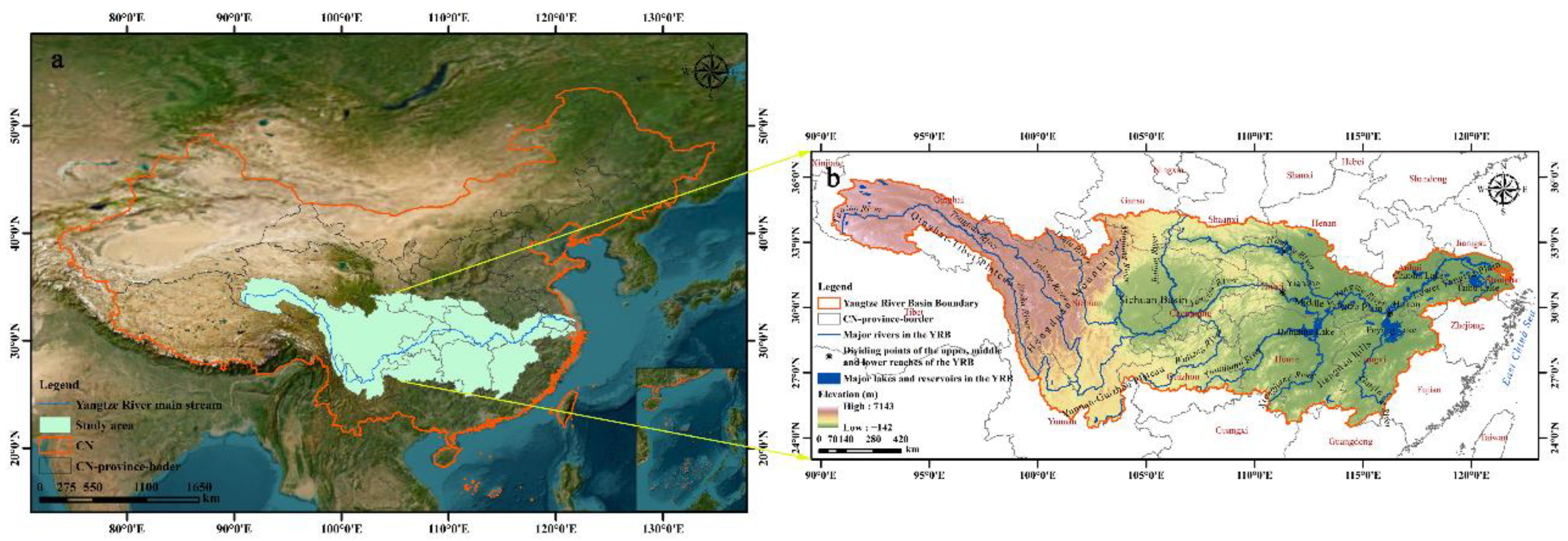
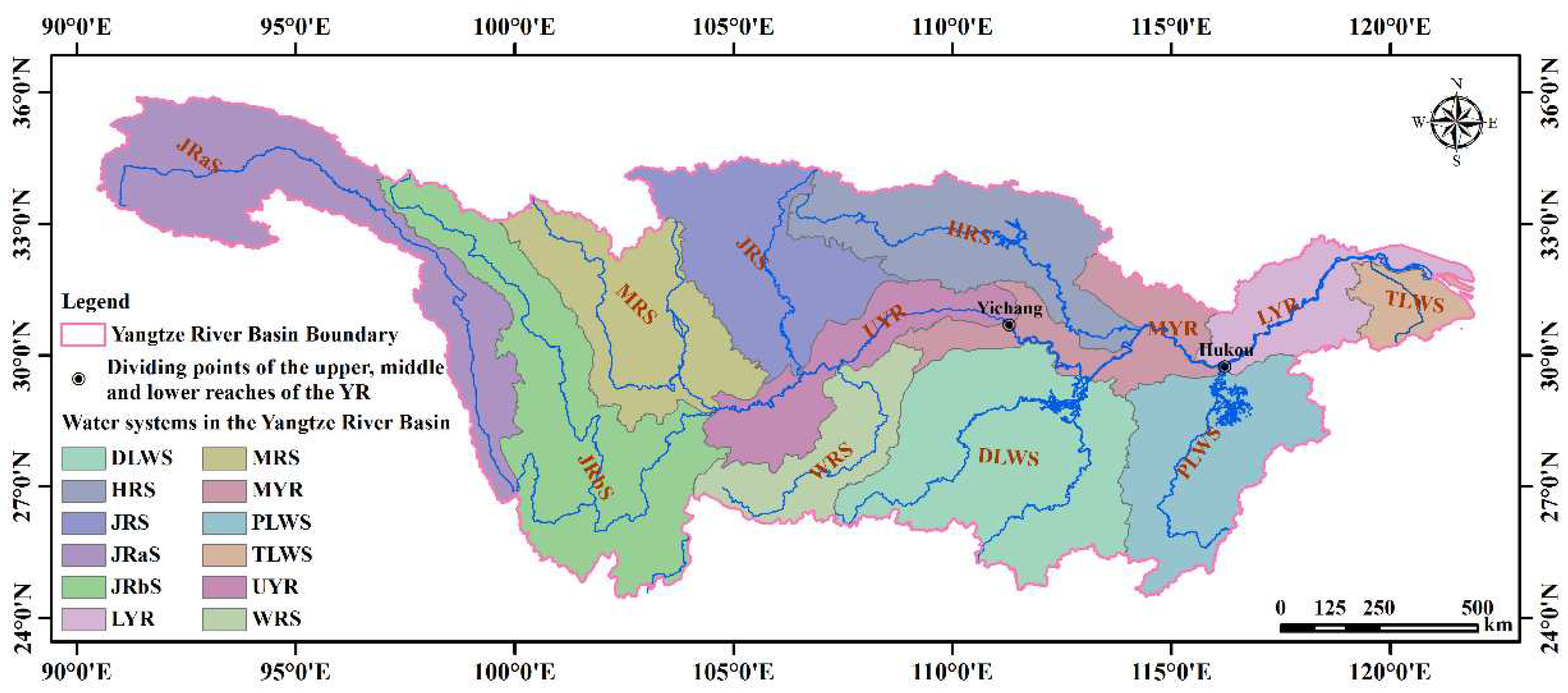
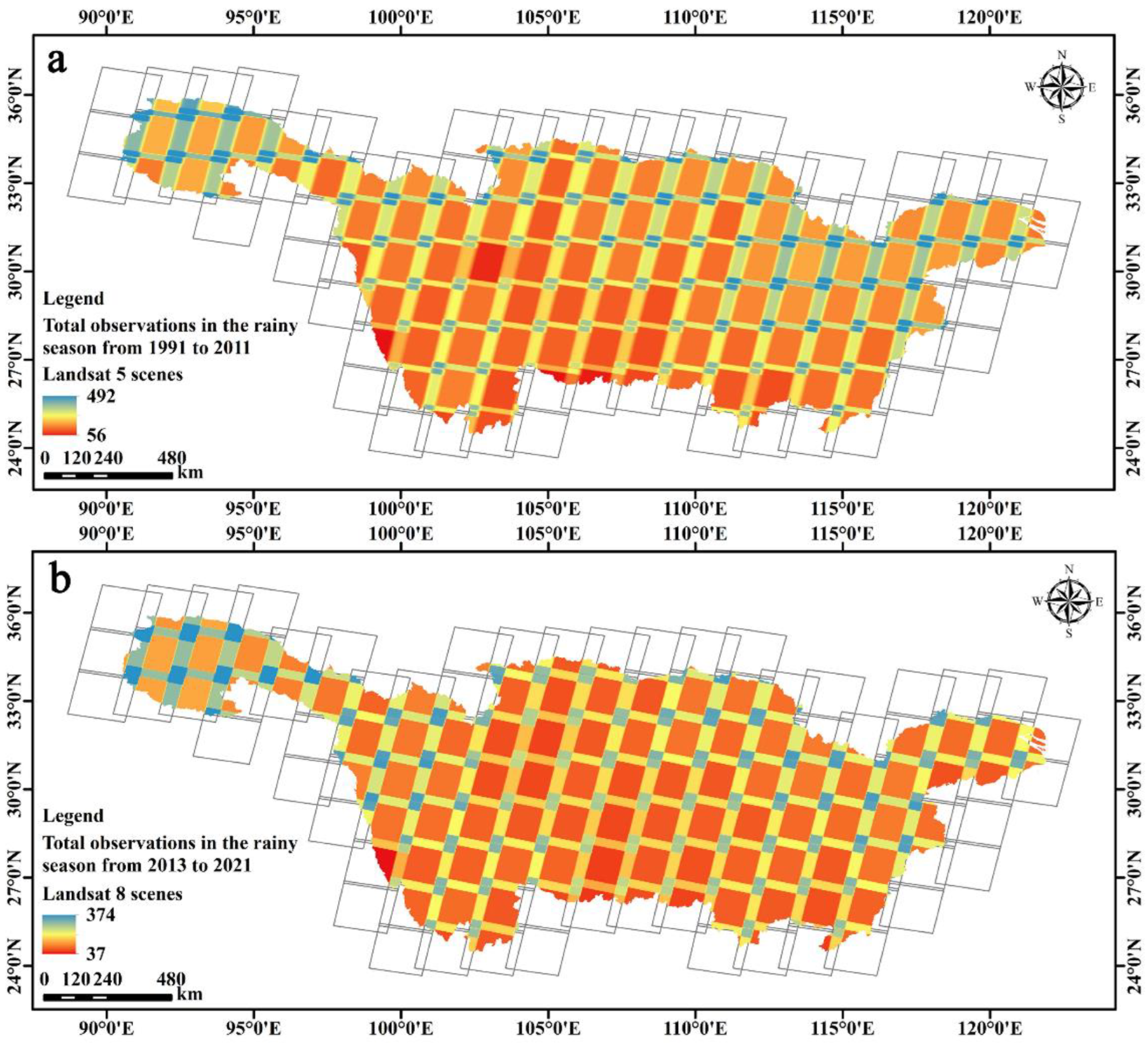
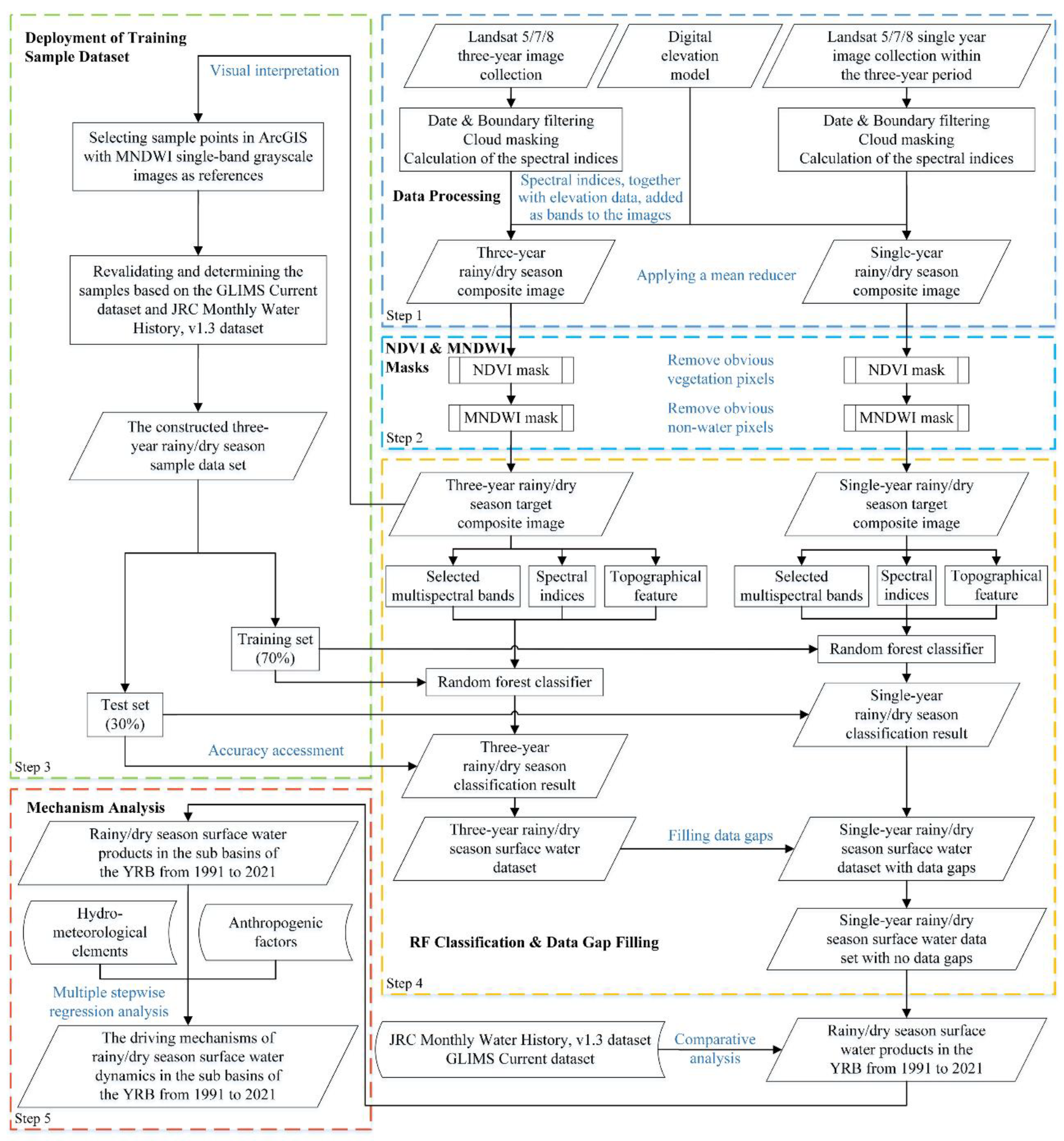
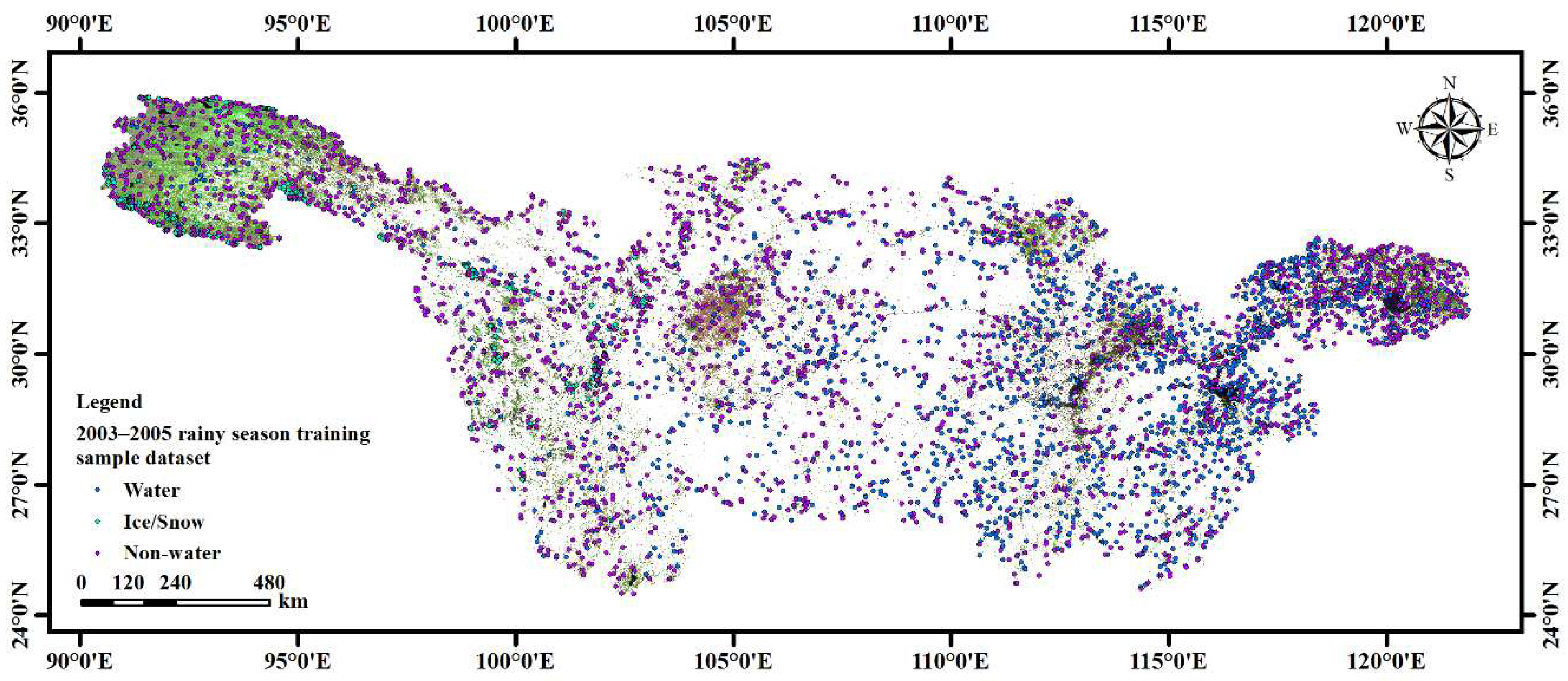
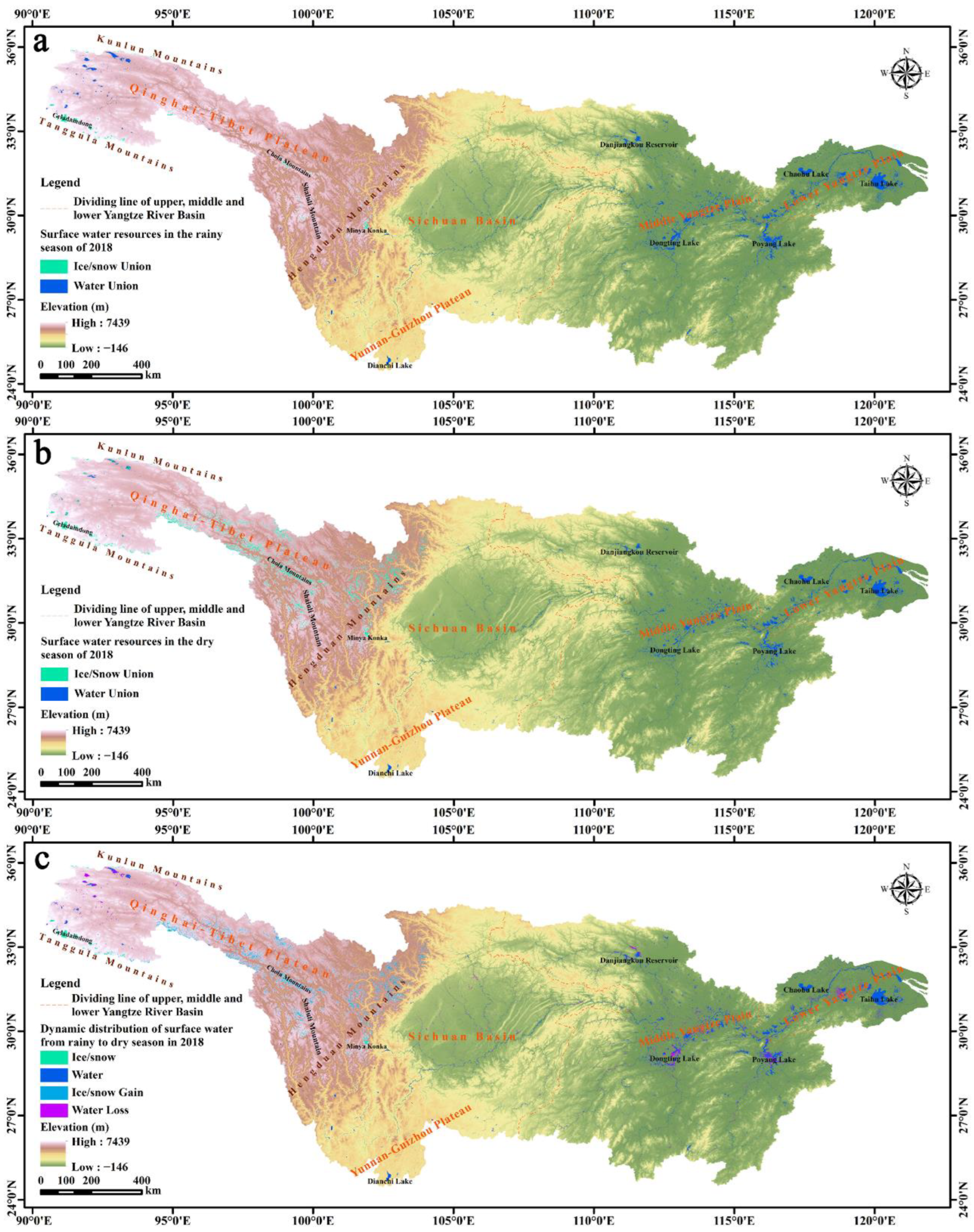
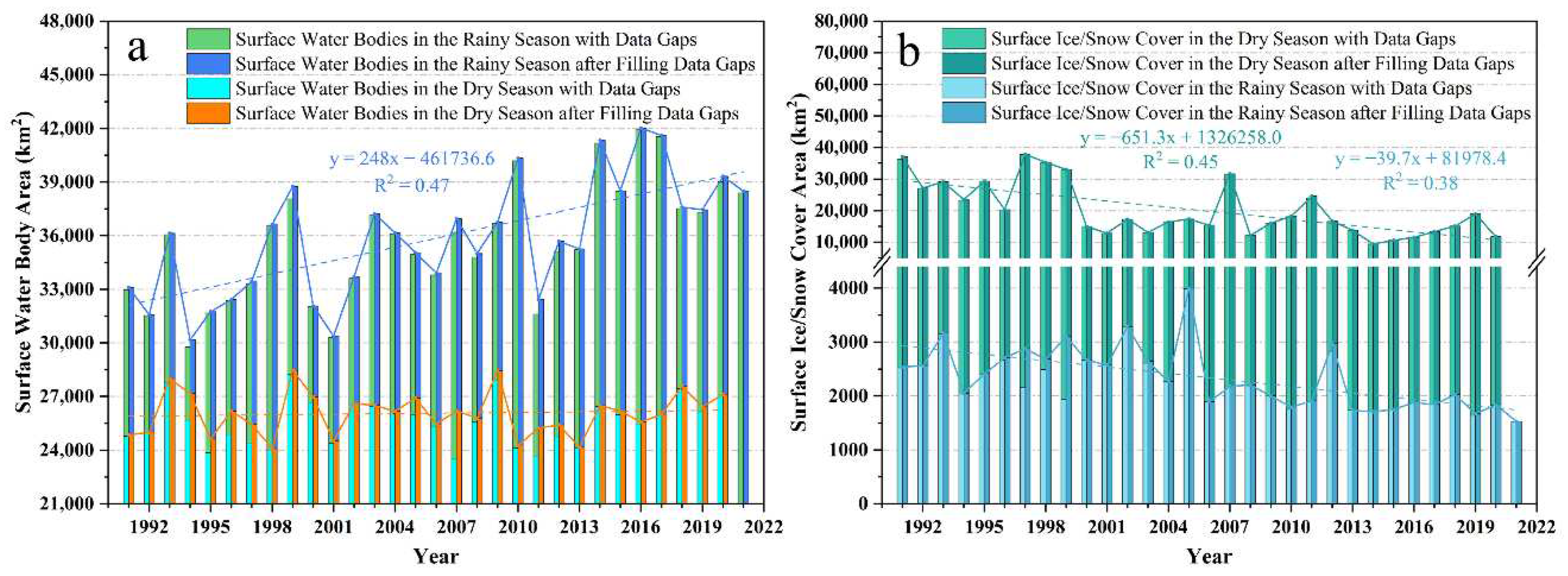
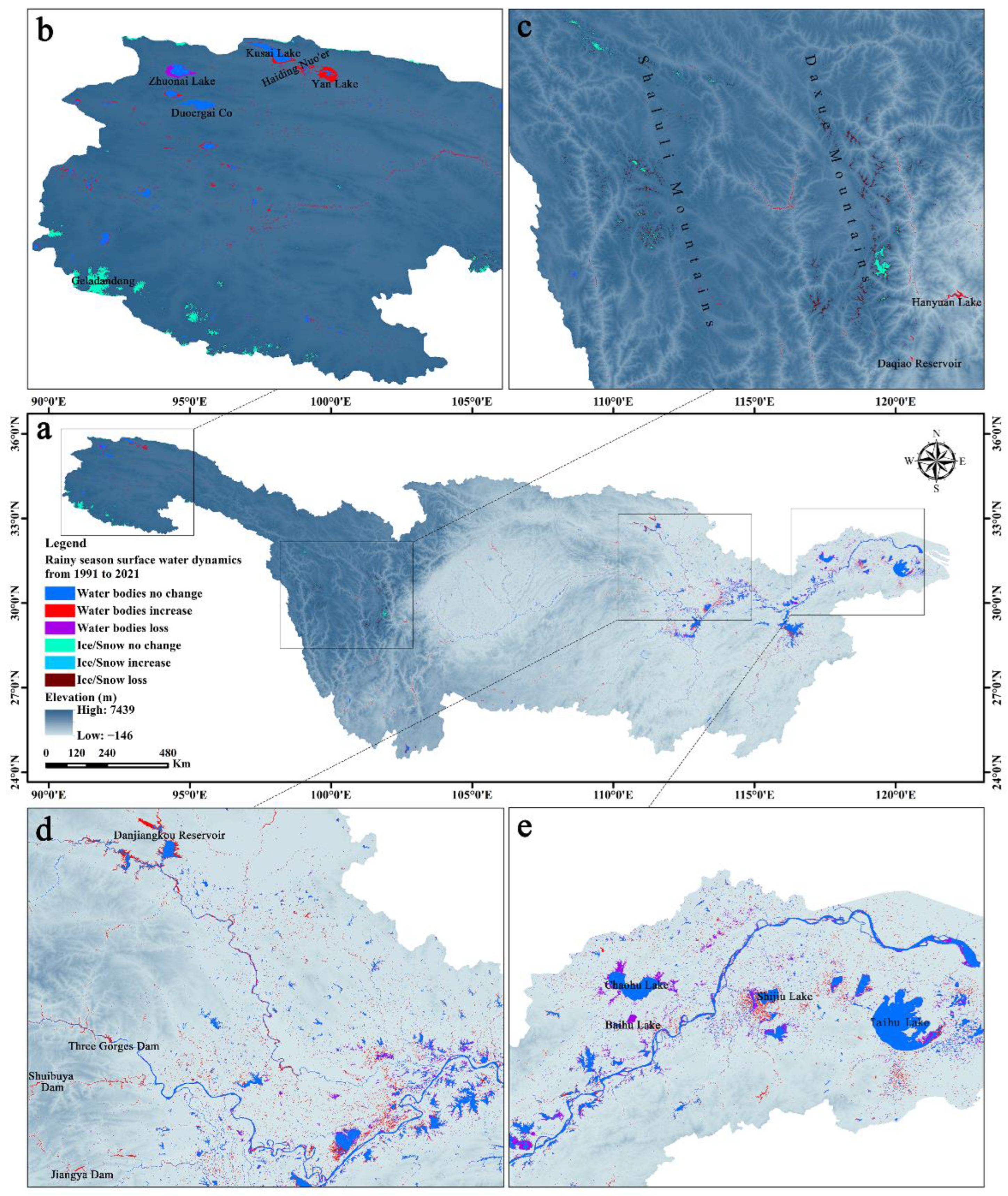

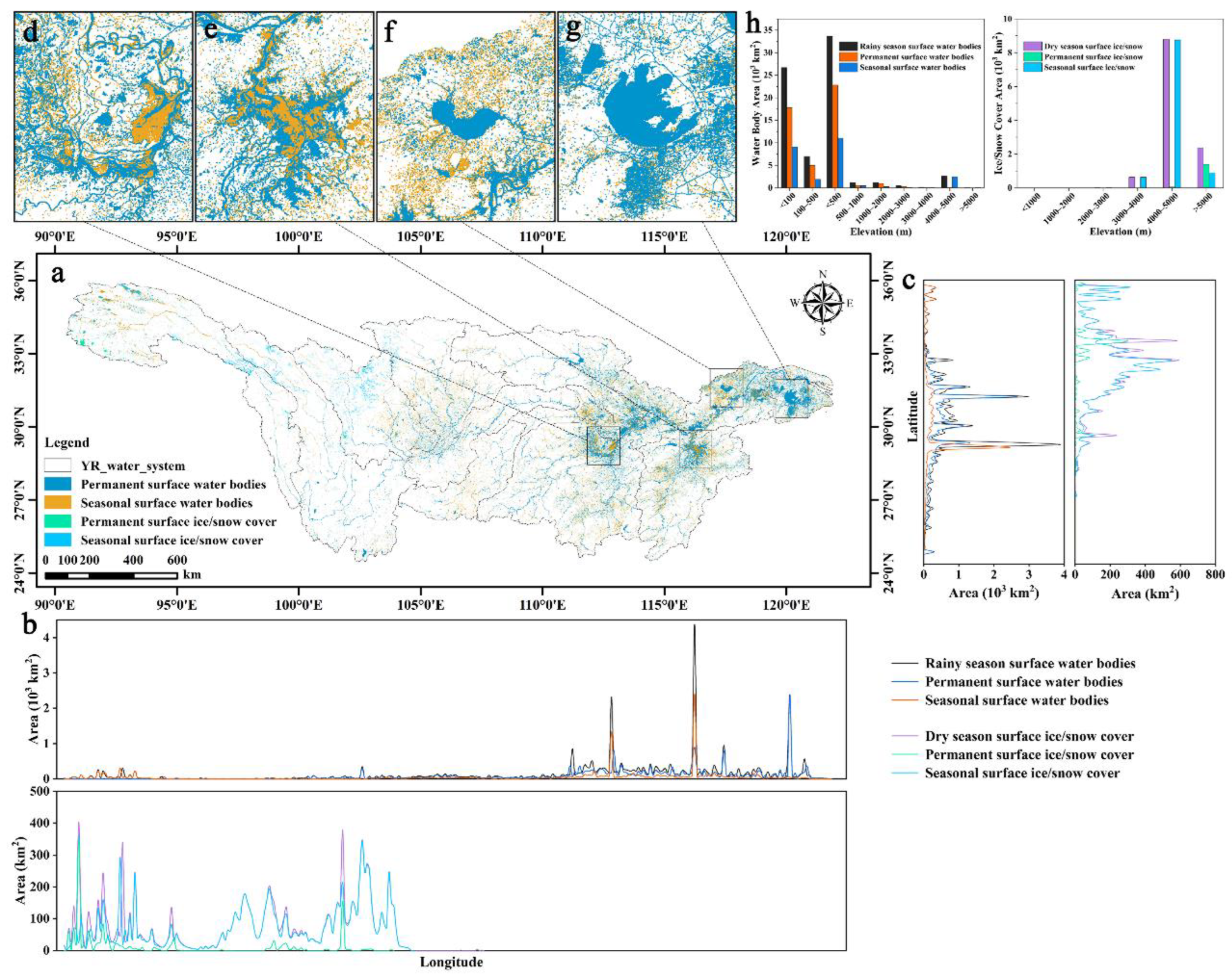

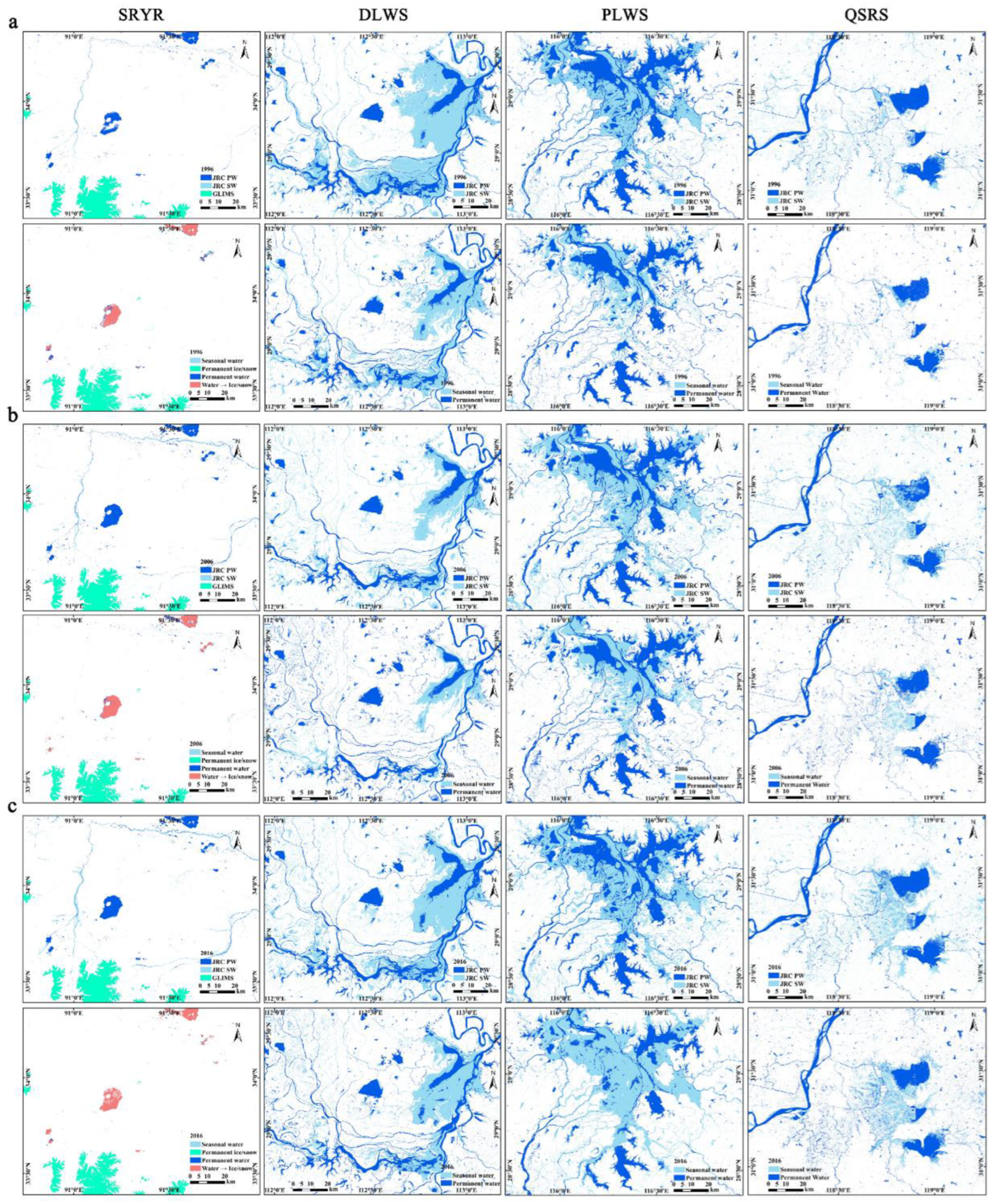
| Land Use/Cover Type | Classification Accuracy | |
|---|---|---|
| UA | PA | |
| Water bodies | 0.96 ± 0.03 | 0.95 ± 0.04 |
| Ice/snow cover | 0.95 ± 0.04 | 0.96 ± 0.04 |
| Non-water | 0.98 ± 0.02 | 0.97 ± 0.02 |
| Water System | Surface Water Bodies in the Rainy Season | Surface Ice/Snow in the Dry Season |
|---|---|---|
| YR | Y1YR= 7061.97 + 34.28 × X1YR (R2 = 0.58, р < 0.05) |
— |
| JRaS | (1) Y1JRaS = −568.44 + 8.2 × X4JRaS (R2 = 0.45, р < 0.001) (2) Y1JRaS = −942.08 + 7.33 × X4JRaS + 139.55 × X3JRaS (R2 = 0.51, р < 0.05) |
Y2JRaS = −7885.14 − 1267.77 × X3JRaS (R2 = 0.42, р < 0.05) |
| JRbS | Y1JRbS = −2825.53 + 307.27 × X3JRbS (R2 = 0.33, р < 0.05) |
Y2JRbS = 6458.02 − 1565.74 × X3JRbS (R2 = 0.19, р < 0.05) |
| MRS | Y1MRS = 338.03 + 2.51 × X5MRS (R2 = 0.32, р < 0.001) |
Y2MRS = 3918.48 − 1155.34 × X3MRS (R2 = 0.26, р < 0.05) |
| JRS | Y1JRS = −2724.16 + 1.09 × X1JRS + 153.68 × X2JRS (R2 = 0.44, р < 0.05) |
— |
| UYR | (1) Y1UYR = 675.79 + 2.86 × X5UYR (R2 = 0.43, р < 0.001) (2) Y1UYR = −1993.45 + 125.6 × X2UYR + 2.73 × X5UYR (R2 = 0.55, р < 0.05) |
— |
| WRS | (1) Y1WRS = 126.52 + 1.56 × X5WRS (R2 = 0.31, р < 0.05) (2) Y1WRS = −2218.12 + 119.53 × X2WRS + 1.52 × X5WRS (R2 = 0.51, р < 0.05) |
— |
| HRS | Y1HRS = 1646.38 + 8.5 × X5HRS (R2 = 0.28, р < 0.05) |
— |
| MYR | Y1MYR = 4644.16 + 5.05 × X5MYR (R2 = 0.28, р < 0.001) |
— |
| DLWS | Y1DLWS = 2867.73 + 2.51 × X1DLWS (R2 = 0.32, р < 0.001) |
— |
| LYR | Y1LYR = 4124.35 + 2.42 × X1LYR (R2 = 0.46, р < 0.001) |
— |
| PLWS | Y1PLWS = 2888.83 + 2.52 × X1PLWS (R2 = 0.49, р < 0.001) |
Y1PLWS = 2787.17 + 3.59 × X5PLWS (R2 = 0.33, р < 0.001) |
| TLWS | — | — |
Disclaimer/Publisher’s Note: The statements, opinions and data contained in all publications are solely those of the individual author(s) and contributor(s) and not of MDPI and/or the editor(s). MDPI and/or the editor(s) disclaim responsibility for any injury to people or property resulting from any ideas, methods, instructions or products referred to in the content. |
© 2024 by the authors. Licensee MDPI, Basel, Switzerland. This article is an open access article distributed under the terms and conditions of the Creative Commons Attribution (CC BY) license (http://creativecommons.org/licenses/by/4.0/).





